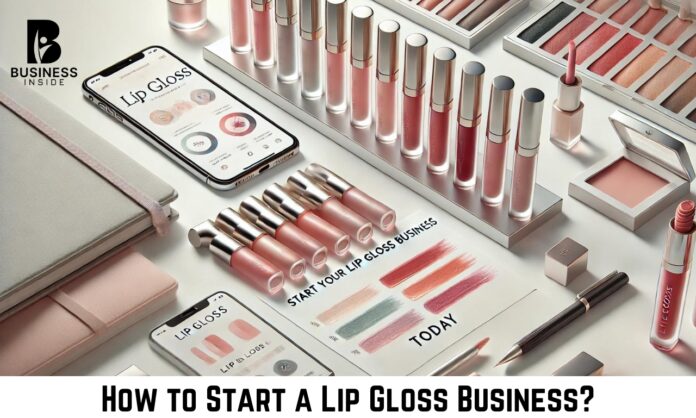The beauty industry is thriving, with lip glosses being a staple in makeup collections around the world. Starting a lip gloss business can be a lucrative endeavor, especially if you have a passion for beauty and an eye for trends. This guide will walk you through the essential steps to launch your own lip gloss business and answer some of the most frequently asked questions.
1. Research the Market
Before you start your lip gloss business, it’s crucial to conduct thorough market research. Understanding the current trends, customer preferences, and your potential competitors will help you position your brand effectively. Identify your target market—whether it’s teens, young adults, or makeup enthusiasts—and explore what types of lip gloss are currently popular, such as matte, glossy, or tinted. This research will inform your product development and marketing strategies, ensuring you meet the needs of your audience.
2. Develop a Business Plan
A solid business plan is the foundation of any successful venture, including a lip gloss business. Include details about your brand’s identity, such as its unique selling points (USPs), and how you plan to differentiate your products in a competitive market. A well-thought-out business plan will guide your operations and be essential if you need to secure funding from investors or financial institutions.
3. Secure Financing
Starting a lip gloss business requires an initial investment in ingredients, packaging, branding, and marketing. Your financial plan should cover the costs of purchasing high-quality ingredients, manufacturing, packaging, marketing, and any necessary certifications. Ensuring you have enough capital to cover these startup costs is crucial for your business’s long-term sustainability.
4. Source High-Quality Ingredients
The quality of your lip gloss will significantly impact your brand’s reputation and customer satisfaction. Partner with reliable suppliers to source high-quality ingredients, such as natural oils, pigments, and moisturizers. Consider offering cruelty-free, vegan, or organic options to cater to the growing demand for ethical and sustainable beauty products. High-quality ingredients not only enhance the performance of your lip gloss but also help differentiate your brand in a crowded market.
5. Choose the Right Packaging
Packaging plays a crucial role in the lip gloss business. It not only protects your product but also serves as a key marketing tool. Invest in attractive, durable, and functional packaging that reflects your brand’s identity. Your packaging should also include essential information such as ingredients, usage instructions, and your brand’s logo. Eye-catching packaging can make your product stand out on retail shelves and online platforms.
6. Develop Your Product Line
Your lip gloss business should offer a variety of products to cater to different customer preferences. Consider offering different finishes, such as matte, glossy, or shimmer, as well as a range of shades to suit various skin tones. You might also want to include lip glosses with added benefits, such as SPF protection or moisturizing properties. Developing a diverse product line can help you attract a broader customer base and increase sales.
7. Focus on Branding and Marketing
Branding is essential in the beauty industry. Your brand should have a clear identity that resonates with your target market. This encompasses your brand’s name, logo, color palette, and overall visual identity. Once your branding is in place, develop a marketing strategy that includes both online and offline efforts. Build a professional website that showcases your products and tells your brand’s story. Use social media platforms like Instagram, TikTok, and Pinterest to connect with potential customers, showcase your products, and build a loyal community. Influencer partnerships, giveaways, and engaging content can also boost your brand’s visibility and drive sales.
8. Set Up an Online Store
An online store is essential for reaching a wider audience and making your products accessible to customers around the world. Platforms like Shopify, WooCommerce, or Etsy make it easy to set up an e-commerce store with user-friendly templates and integrated payment systems. Offering multiple payment options and ensuring a smooth checkout process will enhance the customer experience.
9. Comply with Legal and Regulatory Requirements
Starting a lip gloss business involves adhering to various legal and regulatory requirements. This includes obtaining any necessary licenses and permits, such as a general business license and cosmetic product registration. You’ll also need to comply with labeling regulations, ensuring that your product labels include all required information, such as ingredients, net weight, and manufacturer details. Familiarize yourself with the FDA’s guidelines on cosmetic products if you’re operating in the U.S., or the relevant regulatory body in your country. Ensuring compliance with these regulations will help you avoid legal issues and build customer trust.
10. Launch Your Business
Once you’ve developed your products, set up your online store, and established your branding, it’s time to launch your lip gloss business. Consider hosting a launch event, either in-person or online, to generate excitement and introduce your products to your target audience. Use social media campaigns, email marketing, and influencer partnerships to spread the word about your launch. Offering special promotions, such as discounts or free samples, can also attract initial customers and encourage them to try your products.
Frequently Asked Questions
1. What are the startup costs for a lip gloss business?
Startup costs for a lip gloss business can vary depending on the scale of your operation. Typically, startup costs range from $5,000 to $20,000, covering expenses for ingredients, packaging, branding, and marketing.
2. Do I need a license to start a lip gloss business?
Yes, you will likely need a general business license, and depending on your location, you may also need to register your cosmetic products with the relevant regulatory authorities, such as the FDA in the U.S.
3. How can I stand out in the lip gloss market?
To stand out, focus on offering high-quality, unique products that cater to specific customer needs. Developing a strong brand identity, using eye-catching packaging, and leveraging social media marketing are also key strategies.
4. What are the most popular types of lip gloss?
Common types of lip gloss include glossy, matte, shimmer, and tinted varieties. Additionally, products with added benefits like SPF protection or moisturizing ingredients are in high demand.
- How do I price my lip gloss products?
Pricing should be competitive and reflect the quality of your ingredients and packaging. Consider your target market’s budget and research competitor pricing to set a price point that offers value while maintaining profitability.
Conclusion
Starting a lip gloss business can be a rewarding and profitable endeavor if approached with careful planning and strategic execution. By conducting thorough market research, developing a detailed business plan, sourcing high-quality ingredients, and implementing effective branding and marketing strategies, you can establish a successful lip gloss brand. Remember, staying attuned to customer preferences and industry trends will help you adapt and thrive in the competitive beauty market.

